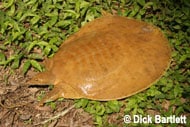Description:
Smooth softshells grow to large size as adults, thus consideration of their eventual needs should be taken into account before acquiring one. Maintaining good water quality is key to maintaining healthy softshell turtles. Smooth softshells like to hide in sand substrates and thus seem to do best in shallow water aquaria where they can completely bury themselves in sand, yet reach their long neck to the surface to breathe. In the wild, they often bury themselves at the downstream ends of sandbars where they can behave in a similar manner. Filtration is essential, although bottom filters may be quickly clogged with sand. Basking sites can be constructed from plastic egg crates, as these can be placed at a slanting angle into the water and allow the turtle to choose whether to emerge completely from the water or bask partially submerged. A basking light that provides warmth, of at least 80 degrees Fahrenheit as well as multi-spectrum lighting, is also important. Smooth softshells may incur injuries when kept with other species of turtles. Smooth softshells are generally carnivorous and will eat live minnows and other small fish, such as mosquitofish (Gambusia sp). In the wild they also eat insect larvae, snails and crayfish. Surprisingly, they have been observed to consume berries and some plant seeds.
Habitat:
Smooth softshells are strictly riverine species and are associated with large rivers, sandy bottoms, and sandbars. They seem to avoid rocky substrates.
Range:
Smooth softshells are found in the Mississippi River drainage and its tributaries from Louisiana north to Minnesota, the Dakotas, and eastward to western Pennsylvania. They are also found in many river drainages in Texas, Oklahoma, Kansas and Nebraska.
Scientific Name: Apalone mutica
Species Group: turtle
Family: Trionychidae
Size: The sexes are strongly dimorphic with females reaching carapace lengths of 14 inches and males only half that size.
Level: advanced
Weight: N/A
Dangerous: No


